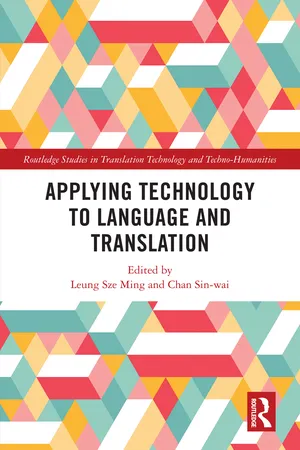
- 240 pages
- English
- ePUB (mobile friendly)
- Available on iOS & Android
Applying Technology to Language and Translation
About this book
A cutting-edge collection of work on the influence and application of new technologies on the study and practice of language and translation.
This book analyzes the relationship between technology, language, and translation in the digital age. Language issues covered include an automatic football commentary system, the use of digital humanities in the versification of Classical Chinese poetry, the application of corpus linguistics in identity construction in Hong Kong, Cantonese speech recognition, and the use of AI in a Chabot system. Other chapters look at translation matters, such as technologies for interpreting, neural machine translation for press releases, computer-aided annotation for translator and interpreter training, and artificial intelligence and translation. As language and translation are closely intertwined, together, these chapters illustrate the drastic changes that technology has brought to these combined areas.
A vital resource for scholars and students studying the impact of technology on language and translation.
Frequently asked questions
- Essential is ideal for learners and professionals who enjoy exploring a wide range of subjects. Access the Essential Library with 800,000+ trusted titles and best-sellers across business, personal growth, and the humanities. Includes unlimited reading time and Standard Read Aloud voice.
- Complete: Perfect for advanced learners and researchers needing full, unrestricted access. Unlock 1.4M+ books across hundreds of subjects, including academic and specialized titles. The Complete Plan also includes advanced features like Premium Read Aloud and Research Assistant.
Please note we cannot support devices running on iOS 13 and Android 7 or earlier. Learn more about using the app.
Information
Table of contents
- Cover
- Half-Title
- Series
- Title
- Copyright
- Contents
- List of figures
- List of tables
- List of contributors
- Introduction
- 1 Time allocation matters in the football commentary: A Hong Kong case
- 2 “In my later phase I gradually get more precise with poetry’s rules?”: Du Fu’s recent style prosody revisited
- 3 Identity construction of Hong Kong’s Chief Executive in blogs: A corpus-informed study
- 4 Exploring a model for ensuring language learner autonomy via technological buttressing
- 5 Improving Cantonese speech-to-text (STT) recognition by using a pronunciation model
- 6 Where neural machine translation and translation memories meet: Domain adaptation for the translation of HKSAR Government press releases
- 7 Computer-aided annotation of lexical cohesive devices in parallel texts for translator and interpreter training
- 8 Exploring creativity in ChatGPT and human translated literature: A case study of The Old Man and the Sea in Chinese
- 9 Making sense of how machines should show human-like emotions
- 10 Explainability of machine translation models: A survey
- Index